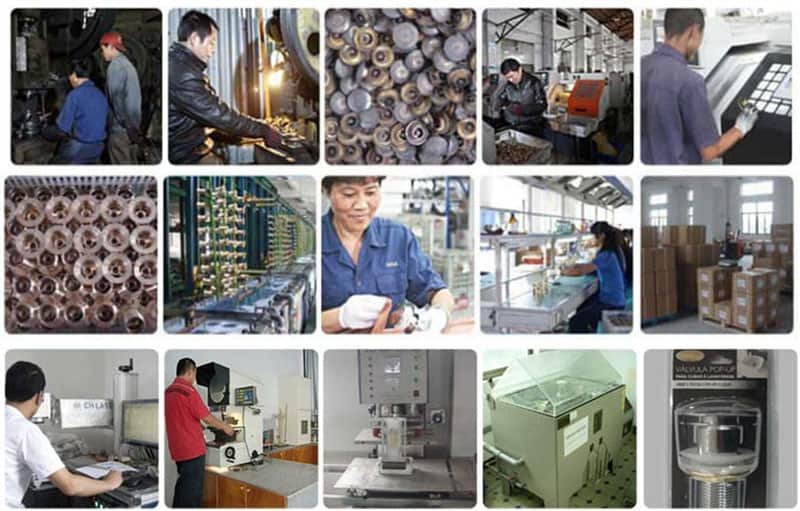Description
Sink Mixer Tap
HF-1116
Are we looking for a stylish and functional sink mixer tap? Look no further than our company! Our faucets are made with history and function in mind, and we have various options to choose from. Whether you’re looking for a traditional or more modern design, we have the perfect tap for you. Plus, all of our faucets are made with high-quality materials and construction. Our sink mixer tap has a long history and many functions. It is made of the finest materials and is precision-engineered to the highest standards. Our sink mixer tap is perfect for any kitchen.
It has a chrome finish that gives it a shiny and elegant look. The tap has a single lever handle that makes it easy to use. The faucet also has ceramic disc cartridges that make it durable.
It comes with a hot and cold water hose, easy to install. The tap has a history of being one of the most popular taps in Europe for over 15 years. The functions include a ceramic disc cartridge that ensures smooth operation and prevents any leaks, and it also comes with a waterfall spout.
The history of the sink mixer tap is a long one. It was first invented in 1930 by Hans Grohe, who was inspired by the design of a kitchen faucet he saw in Paris. The German engineer and entrepreneur set out to make his version that would be more durable and less prone to leaking than traditional faucets. In 1931, Grohe’s company released its first sink mixer tap, installed at the Ritz-Carlton Hotel in New York City. This original model had three spouts instead of two, but it still functions.
The mixer tap is a device that combines the functions of a faucet and a mixer, which can be used to control the flow rate and temperature of the water. The user can use the handle to retain hot and cold water supplies or adjust them separately. In some models, the tap is also equipped with an aerator. These devices are often installed in kitchens and bathrooms but may also be used for other purposes, such as mixing liquids in laboratory work.
Brass Sink Mixer Tap Vs. Stainless Steel Mixer Tap:
When deciding on fixtures for your kitchen or bathroom, the mixer tap’s material can significantly influence your space’s aesthetics, durability, and functionality. Two of the most popular materials used for mixer taps are brass and stainless steel. In this guide, we’ll compare the two, considering their pros, cons, and potential applications, to help you make an informed choice.
What are Brass Sink Mixer Taps?
Brass is an alloy primarily made up of copper and zinc, and it’s been used for many centuries in various applications, including plumbing fixtures.
Pros of Brass Sink Mixer Taps:
- Durability: Brass is known for its durability. A quality brass fixture can last for decades if maintained correctly.
- Finish Options: Brass taps can be polished to a high shine or given a brushed finish. They can also be coated in chrome or nickel for different looks.
- Corrosion Resistant: Brass does not rust, making it suitable for water fixtures.
- Malleability: Due to its malleability, brass can be molded into intricate designs, making it a popular choice for decorative taps.
Cons:
- Tarnishing: Over time, brass can tarnish if not periodically polished, especially if not coated.
- Lead Concerns: Older brass fixtures might contain traces of lead. However, modern fixtures usually adhere to strict lead-free standards.
What about Stainless Steel Mixer Taps?
Stainless steel, primarily made of iron with a mix of carbon and other metals like chromium, is known for its strength and resistance to corrosion.
Pros of Stainless Steel Mixer Taps:
- Modern Look: Stainless steel has a sleek appearance, making it suitable for contemporary kitchens and bathrooms.
- Doesn’t Tarnish: Unlike brass, stainless steel doesn’t tarnish over time.
- Strength: Stainless steel taps tend to be strong and resistant to dents and scratches.
- Hygienic: The non-porous surface of stainless steel makes it resistant to bacteria and easy to clean.
Cons:
- Limited Finish Options: Stainless steel taps typically come in brushed or polished finishes, with fewer design variations than brass.
- Can Show Water Spots: Water spots can be more noticeable on stainless steel, especially on polished finishes.
Which Should You Choose?
1. Aesthetic Preference: Your choice may boil down to the look you’re trying to achieve. Brass might be more suitable if you prefer a classic or vintage look. For a minimalist or industrial vibe, stainless steel can be a better option.
2. Maintenance: Consider the amount of maintenance you’re willing to do. Brass can be a great choice if you don’t mind occasional polishing to prevent tarnishing. If you prefer something more low-maintenance, stainless steel is the way to go.
3. Budget: Typically, brass fixtures tend to be more expensive than stainless steel due to the cost of raw materials and the crafting process. However, prices can vary based on brand, design, and quality.
4. Health Concerns: If looking at older fixtures, be sure that brass taps meet modern standards to avoid lead content. Newer models and reputable brands usually ensure that their brass fixtures are lead-free.
Conclusion
Both brass and stainless steel mixer taps have their own set of advantages and disadvantages. Your choice should align with your aesthetic preferences, maintenance comfort level, budget, and health considerations. Whichever you choose, both materials offer durable and functional solutions for your kitchen or bathroom needs. Ensure you select quality fixtures from reputable manufacturers to guarantee longevity and performance.







